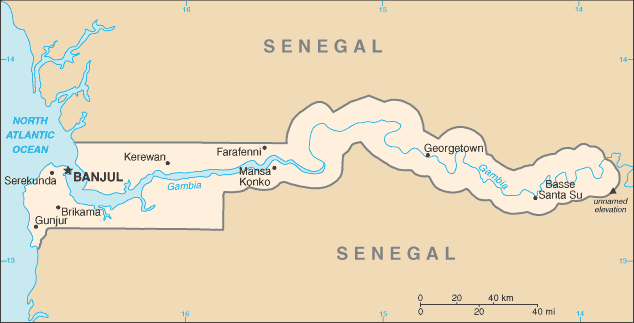| Gambia |
|
|
 |
|
| Geography | |
| Location: | Western Africa, bordering the North Atlantic Ocean and Senegal. |
| Area: | total: 11,295
sq km country comparison to the world: 166 land: 10,000 sq km water: 1,295 sq km |
| Natural Resources: | fish, titanium (rutile and ilmenite), tin, zircon, silica sand, clay, petroleum |
| Population and Health | |
| Population: | 1,8935389 (2013 Census) |
| Age structure: | 0-14 years: 42.7.7% (male 393568/female 391231) |
| Population growth rate: | 3.3% (2013 Census) |
| Birth rate: | 31.75 births/1,000 population (2014 est.) NA |
| Death rate: | 7.26 deaths/1,000 population (2014 est.) NA |
| Sex ratio: | at birth: 1.04 male(s)/female |
| Infant mortality rate: | total: 65.74 deaths/1,000 live births |
| Life expectancy at birth: | total population: 64.36 years |
| Total fertility rate: | 5.6 children born/woman DHS 2013 |
| Current contraceptive use among married women 15-49 years old (any method): | 9% (8% Modern and 1% Traditional) 2013 DHS |
| Unmet need of contraceptive : | 20 % dhs 2013 |
| HIV/AIDS - people living with HIV/AIDS: | infection rate for women age 15-49 is 2.1% and 1.7% for men within the same age group (DHS 2013) |
| HIV/AIDS - deaths: | 500 (2012) NA |
| Literacy: | definition: age 15 and over can read and write |
| Economy | |
| GDP (purchasing power parity): | $3.678 billion (2013 est.) |
| GDP (official exchange rate): | $896 million (2013 est.) |
| GDP - real growth rate: | 6.4% (2013 est.) |
| GDP - per capita (PPP): | $2,000 (2013 est.) |
| GDP - composition by sector: | agriculture: 19.7% |
| Labor force - by occupation: | agriculture: 75% |
| Inflation rate (consumer prices): | 6% (2013 est.) |
| Agriculture - products: | rice, millet, sorghum, peanuts, corn, sesame, cassava (manioc), palm kernels; cattle, sheep, goats |
| Industries: | processing peanuts, fish, and hides; tourism, beverages, agricultural machinery assembly, woodworking, metalworking, clothing |
| Industrial production growth rate: | 3.4% (2013 est.) |
| Exports - commodities: | peanut products, fish, cotton lint, palm kernels, re-exports |
| Currency (code): | Dalasi (GMD) |
| Fiscal year: | calendar year |
| Others | |
| Nationality: | noun: Gambian(s) adjective: Gambian |
| Religions: |
Muslim 90%, Christian 8%, indigenous beliefs 2% |
| Languages: |
English (official), Mandinka, Wolof, Fula, other indigenous vernaculars |
| Country name: | conventional
long form: Republic of The Gambia conventional short form: The Gambia |
| Government type: | Republic |
| Capital: | name: Banjul
geographic coordinates: 12 28 N, 16 39 W time difference: UTC 0 (5 hours ahead of Washington, DC during Standard Time) |
| Administrative divisions: | 5 Regions and 2 Municipalities Central River, Lower River, North Bank, Upper River, Western Coast, KMC and BCC |
| Independence: | 18 February 1965 (from UK) |
| Legal system: | based on a composite of English common law, Islamic law, and customary law; accepts compulsory ICJ jurisdiction, with reservations |
|
|
Source : UN_Demographic and Health Surveys (DHS), Multiple Indicator Cluster Surveys (MICS) and other national surveys; United Nations Population Division Update date: August 2014 |
|